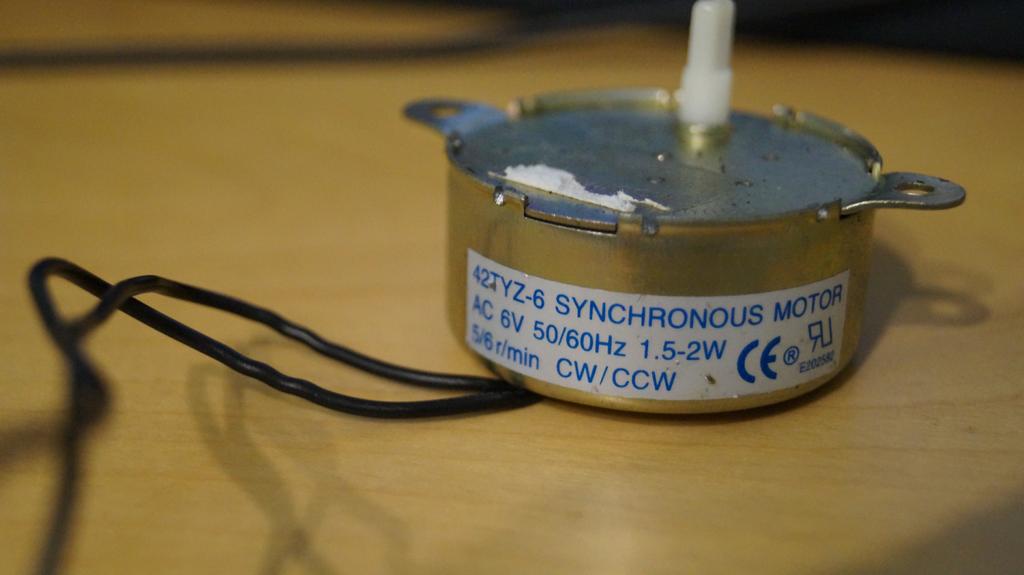I was taking apart this thing that I bought from the dollar store, its this glass block with an encased sculpture that sits on a revolving deck. (see photo below) The deck powers 4 LEDS with batteries, however it must be plugged in to turn. I found that the motor that was used was a AC 6V Synchronous Motor (see photo below). I have no idea why a simple DC motor could not have been used, eliminating the expense of using this motor and allowing the deck to turn on battery power. The block is not heavy, only around 480 grams. Can anyone shed some light on why this motor was used? I'm curious. Thanks!


-
1\$\begingroup\$ Their budget didn't allow them to source new DC motors, so they had to use the AC motors they already had. \$\endgroup\$– Ignacio Vazquez-AbramsCommented Aug 26, 2013 at 2:32
-
\$\begingroup\$ Because the engineer's brother was the sales rep for that motor manufacturer. Or an accountant's son set up a shell company to buy cheap and sell high. \$\endgroup\$– PasserbyCommented Aug 26, 2013 at 2:52
-
\$\begingroup\$ So you guys think there really was no reason to choose this motor from a purely design standpoint? \$\endgroup\$– MichaelKCommented Aug 26, 2013 at 2:58
-
1\$\begingroup\$ @Aliasmk When it comes to making things very cheap, you rarely choose things from a purely design standpoint. \$\endgroup\$– user3624Commented Aug 26, 2013 at 3:10
-
3\$\begingroup\$ Finally, some unicorns for us; not just StackOverflow! \$\endgroup\$– JYeltonCommented Aug 26, 2013 at 3:22
3 Answers
I'd say this was purely to reduce cost. With an AC motor, the device can use a transformer to step down the voltage (probably a cheap wall-wart), but skip having a bridge rectifier to convert it to DC. Further, AC gear motors are cheaper:
AC motors are generally smaller, less expensive, lighter and more rugged than DC motors. DC motors, on the other hand, are generally considered better for variable speed operations.
Since this device doesn't require variable speed, the AC gear motor choice seems obvious.
It must have been less expensive to provide a battery clip for the LEDs than a few diodes for DC conversion. (Or maybe lighting it was an afterthought.)
As to why the motor isn't DC and runs off batteries, I expect this is something you'd leave on for a while, and small (presumably AA cells?) would not run a motor continuously for very long.
-
\$\begingroup\$ Thanks. I guess I figured that DC motors would be cheaper (probably considering how many I have from other things!). \$\endgroup\$– MichaelKCommented Aug 26, 2013 at 3:41
Without something to close a control loop, a DC motor would run at variable speed during the life of the batteries, from too fast to too slow to not at all. But the synchronous AC motor runs at the desired speed (modulo being moved between 60Hz and 50 Hz countries) because it is functionally quite similar to a stepper motor driven by, and locked to, the AC line frequency.
I wouldn't be surprised if the batteries are in the rotating portion? If so that saves the need of slip rings or inductive coupling.
Motors consume a lot of power. Your batteries can run the LEDs a long time for the amount of energy a small motor uses in a few minutes.
AC motors are much more reliable than DC motors because DC motors require brushes and commutators to transfer power to the turning armature.
AC motors can be made to turn locked to a low fixed fraction of the power line frequency. Low motor speed comes out to a lot less turns of the bearings, and therefor longer life.
AC motors are cheaper than DC motors for slow speeds. Such synchronous motors are cheaply available as clock drives with reduction gearboxes attached. Reduction gearboxes on DC motors are custom products for niche markets and are very expensive.
